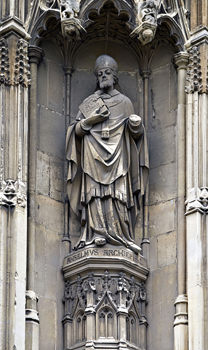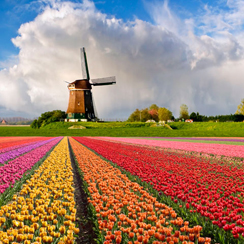Last month I read Timothy Egan's new book A Pilgrimage to Eternity: From Canterbury to Rome in Search of a Faith (2019). Egan's previous work has earned him a share in a Pulitzer Prize as a reporter with the NY Times, and a National Book Award for his book about the Dust Bowl called The Worst Hard Time (2006). Having made three pilgrimages myself — the Camino Santiago in Spain, the route across southern France called Le Chemin du Puy, and La Via di Francesco from Florence to Assisi to Rome, I was immediately drawn to Egan's story.
Egan calls himself a "lapsed but listening" Catholic who is a "skeptic by profession." But he wanted to "remain open to new possibilities," and so a few years ago he walked the ancient Canterbury Trail for a thousand miles from southeast England to St. Peter's Square in Rome. Does God still exist in a secularized Europe that was once the cradle of Christianity — home to 3,000 monasteries by the year 1400, but where today eight out of ten Swedish people identify themselves as atheist?
Egan's memoir tells three related stories. The first is like a good travelogue of church history, art, architecture, literature, geography, and politics. He describes the people, places, and events that are associated with the Canterbury Trail, like Augustine, the Protestant Reformation, Napoleon, Galileo, and monasteries where prayer has continued unabated for a millennium. Second, he repeatedly confronts the horrible abuses of the church that are also a part of this path: the Holocaust, pedophilia among priests ($2 billion in settlements), Christians killing Jews, Muslims and fellow Christians, the Crusades, the Inquisition, and so on. These abuses raise serious questions for those of us who seek an authentic faith. Third, there is Egan's personal search for a renewed faith, and that's where I discovered some Lenten lessons from the Canterbury Trail.
 |
|
TImothy Egan.
|
Egan isn't interested in some vague affirmation of a remote deity. He wants something definitive, something clear and certain: "I'm looking for something stronger: a stiff shot of no-bullshit spirituality." But how do you square the circle of both the Holocaust and the Prince of Peace, of St. Peter's Basilica and a peasant rabbi from Galilee, of arguments for and against the existence of God?
His spiritual pilgrimage begins in one place, with a lofty goal in mind, but it ends in a different place. However much he seeks clarity and certainty, at the end he's left with ambiguity and nagging questions. He discovers that he must do a delicate dance between faith and reason; he must "maintain my wonder of what could be, while never forgetting what was." The opposite of faith, it turns out, isn't doubt, it's certitude.
The Yale poet Christian Wiman says something similar to this in his own memoir called My Bright Abyss (2013). "What I crave," says Wiman, "is some speech that is true to the transcendent nature of grace yet equal to the hard reality in which daily faith operates." He seeks that elusive balance between "active devotion and honest modern consciousness." He searches for "the sanity and vitality of this strange, ancient thing" called Christian faith.
Egan reminded me of how at Lent we affirm both the brutal reality of what is, and the fervent hope for what will be. We live between the Lenten reminder of certain death and the Easter affirmation of resurrection life. With an understandable sense of futility that is nonetheless countered by God's new possibilities. We live between this age and the age to come, between the Already and Not Yet of God's kingdom. Between the first and the last Adam, flesh and spirit, comfort and affliction, sin that abounds and grace that abounds all the more. We are what Augustine called "intermediate beings" who are poised between beasts and angels, between time and eternity. Because of that, we see through a glass darkly rather than perfectly.
A favorite poem by George Herbert (1593–1633) captures our ambiguous identity as "intermediate beings." In his poem Affliction (IV), Herbert describes us as "tortured wonders" who live "betwixt" human nature and divine grace.
Broken in pieces all asunder,
Lord, hunt me not,
A thing forgot,
Once a poor creature, now a wonder,
A wonder tortur’d in the space
Betwixt this world and that of grace.
My thoughts are all a case of knives,
Wounding my heart
With scatter’d smart,
As wat’ring pots give flowers their lives.
Nothing their fury can control,
While they do wound and prick my soul.
All my attendants are at strife,
Quitting their place
Unto my face:
Nothing performs the task of life:
The elements are let loose to fight,
And while I live, try out their right.
Oh help, my God! let not their plot
Kill them and me,
And also thee,
Who art my life: dissolve the knot,
As the sun scatters by his light
All the rebellions of the night.
Then shall those powers, which work for grief,
Enter thy pay,
And day by day
Labour thy praise, and my relief;
With care and courage building me,
Till I reach heav’n, and much more, thee.
Herbert's poetry reflects his lifelong struggle between his privileged background and worldly ambitions as a Member of Parliament and the Cambridge University faculty, and his choice to live as a poor cleric in rural England.
 |
|
The statue of Anselm on the southwest porch of Canterbury Cathedral, holding a copy of Cur Deus Homo in its right hand.
|
When Egan descended the alps of northwest Italy into the town of Aosta, he stopped at the birth place of Saint Anselm (1033–1109) — the Benedictine monk, abbot, philosopher, theologian, and archbishop of Canterbury. Here, it would seem, was a bona fide saint who could provide the "stiff shot" of certitude that Egan wanted — an irrefutable proof for the existence of God that Anselm considered so self-evident that even a fool could grasp it. Almost a thousand years later our best minds still debate the merits of Anselm's famous "ontological argument."
A dinner conversation with his daughter next door to 66 Via Sant'Anselmo proved pivotal in Egan's search. He concluded that you cannot prove the existence of God by an exercise of human logic. That left him with a more nuanced faith that Anselm articulated in his Proslogion: "I do not even try, Lord, to rise up to your heights, because my intellect does not measure up to that task; but I do want to understand in some small measure your truth, which my heart believes in and loves. Nor do I seek to understand in order to believe, but rather I believe so that I can understand."
At the end of the Canterbury Trail, Egan resonates with Saint Benoit Labre, the Vagabond of God and patron saint of wanderers, who remained homeless his entire life, and who observed that "there is no way. The way is made by walking." His renewed faith, he concluded, "was not served in a stiff shot. A stiff shot does not last."
Dan Clendenin: dan@journeywithjesus.net
Image credits: (1) Twitter.com and (2) Wikipedia.org.



